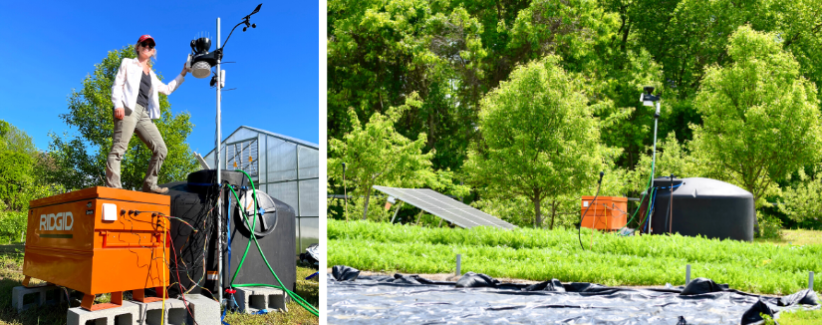From the Lab to the Farm

MIT Brings a Drip Irrigation Prototype to Gaining Ground’s Fields
“What’s that?” has been a particularly frequent question from our volunteers this year, and they’re not just talking about equipment, plants, insects, or other common farm-related mysteries.
This year, the source of curiosity has tended to be a massive black drum, orange metal box, and solar panel taking up residence along several beds of lettuce just past our hoop houses. And folks have good reason to take notice; it’s not every day that we have a group of students researching irrigation at the farm.
The equipment is a prototype of a low-cost, solar-powered drip irrigation system being developed at MIT to help ensure farmers are able to sustainably grow crops in parts of the world where populations are rising but access to fresh water is under threat. Behind the project is the Global Engineering and Research (GEAR) Lab at MIT, which focuses on creating specialized technologies—using fresh scientific and engineering insight—with the hope of having a positive impact on the world.

This past winter, Carolyn Sheline, a PhD student in the GEAR lab working on the drip irrigation team, reached out to Farm Manager Anna Kelchlin to find out if there might be a place at Gaining Ground where she and some fellow researchers could set up drip irrigation on several beds of lettuce. The irrigation team was hoping to validate the performance of their system in a farm setting. After some logistics were worked out—such as placement for the equipment, planning for how the water drum would be filled, and selecting appropriate beds on the crop plan slated to grow lettuce—the farm and the GEAR lab set about making it happen.
In parts of the world experiencing water shortages and groundwater depletion, drip irrigation options for farmers could greatly reduce water consumption and improve crop yield. A major barrier for farmers tends to be access to these technologies; the capital costs for the equipment can be high and many agricultural regions lack access to an electrical grid to power water pumps.
A particular challenge has been to improve the overall efficiency of irrigation scheduling—and this is what brings the project to Gaining Ground. A system that is better timed with weather conditions can waste less water and energy, while increasing harvests. To address this issue, the GEAR lab developed a lower-cost system controller that uses weather sensors and information about crop water demand to create a daily irrigation schedule that is water- and energy-efficient.

The lab has created a prototype of this controller and they are working at Gaining Ground this summer to study its performance in our fields.
“The project is going great,” said Carolyn, who is spearheading the project at the farm. “We are able to remotely monitor the weather, soil moisture, irrigation amount, and energy use of the solar-powered drip irrigation system on the three beds of lettuce. We are using this data to validate our models for our solar-powered irrigation controller.”
At Gaining Ground, we’ve been grateful this season that our land and crops could be a part of a project seeking to improve access for farmers to sustainable systems for growing food. Climate change is already disrupting historic weather and climate patterns around the world, and we know that drought will have a major impact on the health and wellbeing of millions of people. We are excited to see where the GEAR lab’s irrigation project leads, and want to express our thanks to their team for bringing such a curious, thoughtful presence to our farm in the course of their research.